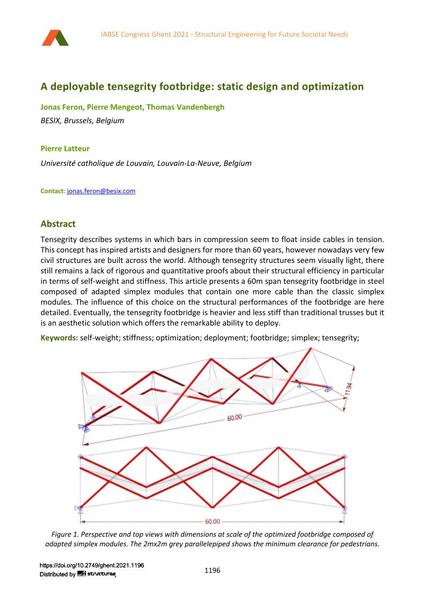A deployable tensegrity footbridge: static design and optimization

|
|
|||||||||||
Bibliographic Details
| Author(s): |
Jonas Feron
(BESIX, Brussels, Belgium)
Pierre Mengeot (BESIX, Brussels, Belgium) Thomas Vandenbergh (BESIX, Brussels, Belgium) Pierre Latteur (Université catholique de Louvain, Louvain-La-Neuve, Belgium) |
||||
|---|---|---|---|---|---|
| Medium: | conference paper | ||||
| Language(s): | English | ||||
| Conference: | IABSE Congress: Structural Engineering for Future Societal Needs, Ghent, Belgium, 22-24 September 2021 | ||||
| Published in: | IABSE Congress Ghent 2021 | ||||
|
|||||
| Page(s): | 1196-1204 | ||||
| Total no. of pages: | 9 | ||||
| DOI: | 10.2749/ghent.2021.1196 | ||||
| Abstract: |
Tensegrity describes systems in which bars in compression seem to float inside cables in tension. This concept has inspired artists and designers for more than 60 years, however nowadays very few civil structures are built across the world. Although tensegrity structures seem visually light, there still remains a lack of rigorous and quantitative proofs about their structural efficiency in particular in terms of self-weight and stiffness. This article presents a 60m span tensegrity footbridge in steel composed of adapted simplex modules that contain one more cable than the classic simplex modules. The influence of this choice on the structural performances of the footbridge are here detailed. Eventually, the tensegrity footbridge is heavier and less stiff than traditional trusses but it is an aesthetic solution which offers the remarkable ability to deploy. |
||||
| Keywords: |
footbridge optimization stiffness tensegrity self-weight deployment simplex
|
||||
| Copyright: | © 2021 International Association for Bridge and Structural Engineering (IABSE) | ||||
| License: | This creative work is copyrighted material and may not be used without explicit approval by the author and/or copyright owner. |
||||

